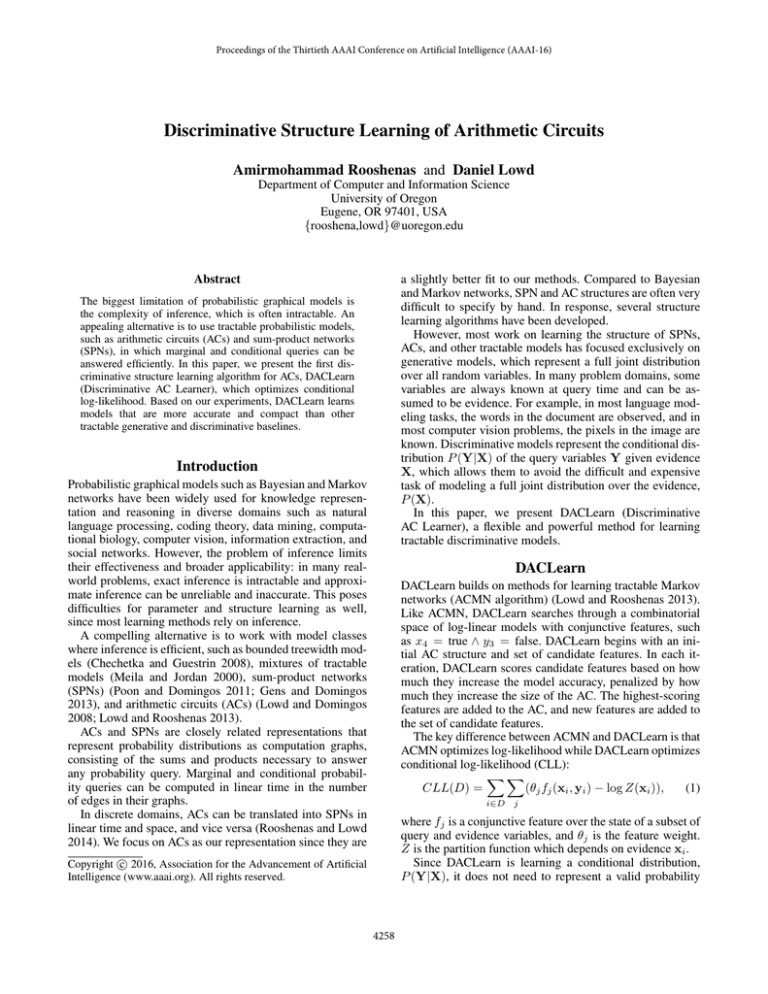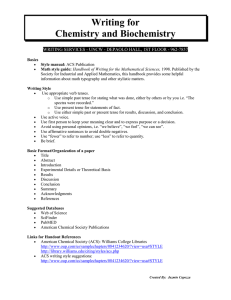
Proceedings of the Thirtieth AAAI Conference on Artificial Intelligence (AAAI-16)
Discriminative Structure Learning of Arithmetic Circuits
Amirmohammad Rooshenas and Daniel Lowd
Department of Computer and Information Science
University of Oregon
Eugene, OR 97401, USA
{rooshena,lowd}@uoregon.edu
a slightly better fit to our methods. Compared to Bayesian
and Markov networks, SPN and AC structures are often very
difficult to specify by hand. In response, several structure
learning algorithms have been developed.
However, most work on learning the structure of SPNs,
ACs, and other tractable models has focused exclusively on
generative models, which represent a full joint distribution
over all random variables. In many problem domains, some
variables are always known at query time and can be assumed to be evidence. For example, in most language modeling tasks, the words in the document are observed, and in
most computer vision problems, the pixels in the image are
known. Discriminative models represent the conditional distribution P (Y|X) of the query variables Y given evidence
X, which allows them to avoid the difficult and expensive
task of modeling a full joint distribution over the evidence,
P (X).
In this paper, we present DACLearn (Discriminative
AC Learner), a flexible and powerful method for learning
tractable discriminative models.
Abstract
The biggest limitation of probabilistic graphical models is
the complexity of inference, which is often intractable. An
appealing alternative is to use tractable probabilistic models,
such as arithmetic circuits (ACs) and sum-product networks
(SPNs), in which marginal and conditional queries can be
answered efficiently. In this paper, we present the first discriminative structure learning algorithm for ACs, DACLearn
(Discriminative AC Learner), which optimizes conditional
log-likelihood. Based on our experiments, DACLearn learns
models that are more accurate and compact than other
tractable generative and discriminative baselines.
Introduction
Probabilistic graphical models such as Bayesian and Markov
networks have been widely used for knowledge representation and reasoning in diverse domains such as natural
language processing, coding theory, data mining, computational biology, computer vision, information extraction, and
social networks. However, the problem of inference limits
their effectiveness and broader applicability: in many realworld problems, exact inference is intractable and approximate inference can be unreliable and inaccurate. This poses
difficulties for parameter and structure learning as well,
since most learning methods rely on inference.
A compelling alternative is to work with model classes
where inference is efficient, such as bounded treewidth models (Chechetka and Guestrin 2008), mixtures of tractable
models (Meila and Jordan 2000), sum-product networks
(SPNs) (Poon and Domingos 2011; Gens and Domingos
2013), and arithmetic circuits (ACs) (Lowd and Domingos
2008; Lowd and Rooshenas 2013).
ACs and SPNs are closely related representations that
represent probability distributions as computation graphs,
consisting of the sums and products necessary to answer
any probability query. Marginal and conditional probability queries can be computed in linear time in the number
of edges in their graphs.
In discrete domains, ACs can be translated into SPNs in
linear time and space, and vice versa (Rooshenas and Lowd
2014). We focus on ACs as our representation since they are
DACLearn
DACLearn builds on methods for learning tractable Markov
networks (ACMN algorithm) (Lowd and Rooshenas 2013).
Like ACMN, DACLearn searches through a combinatorial
space of log-linear models with conjunctive features, such
as x4 = true ∧ y3 = false. DACLearn begins with an initial AC structure and set of candidate features. In each iteration, DACLearn scores candidate features based on how
much they increase the model accuracy, penalized by how
much they increase the size of the AC. The highest-scoring
features are added to the AC, and new features are added to
the set of candidate features.
The key difference between ACMN and DACLearn is that
ACMN optimizes log-likelihood while DACLearn optimizes
conditional log-likelihood (CLL):
(θj fj (xi , yi ) − log Z(xi )),
(1)
CLL(D) =
i∈D
j
where fj is a conjunctive feature over the state of a subset of
query and evidence variables, and θj is the feature weight.
Z is the partition function which depends on evidence xi .
Since DACLearn is learning a conditional distribution,
P (Y|X), it does not need to represent a valid probability
c 2016, Association for the Advancement of Artificial
Copyright Intelligence (www.aaai.org). All rights reserved.
4258
show the effect of discriminative parameter learning, we also
take the best models learned by EACMN, based on the average log-likelihood on validation data, and optimize their parameters in order to maximize the conditional log-likelihood
(CLL) of P (Y|X). We call this method conditional ACMN
(CAMCN). Finally, we choose MCTBN (Hong, Batal, and
Hauskrecht 2014) as our last baseline, which learns a mixture of conditional tree Bayesian networks.
For all of the above methods, we learn the model using
the training data and tune the hyper-parameters using the
validation data, and we report the average CLL over the test
data. To tune the hyper-parameters, we used a grid search
over the hyper-parameter space. We bounded the learning
time of all methods to 24 hours.
Table 1 summarizes our experiments by showing the number of time that DACLearn is significantly better (win), not
different (tie), or worse (loss) than the baselines based on the
average CLL in the presence of 50% and 80% evidence variables. Wins and losses are determined by two-tailed paired
t-tests (p < 0.05) on the test set CLL. MCTBN and CACMN
reach the 24 hour limit on some datasets, so we exclude
those experiments. DACLearn is significantly more accurate
than our baselines on at least half the experiments.
Table 1 shows that discriminative parameter learning
(CACMN) is less accurate than discriminative structure
learning (DACLearn).
As we mention earlier, discriminative ACs are more compact than generative ACs. The average size of the circuits
learned by IDSPN and EACMN are 2.2M and 1.1M edges,
respectively, while the average size of the circuits learned by
DACLearn is 55K edges when we have 50% evidence variables and 22K edges when we have 80% evidence variables.
This means that inference in discriminative ACs is 100 times
faster than IDSPN when we have 80% evidence variables.
Table 1: Number of DACLearn wins/ties/losses compared to
other baselines with 50% and 80% of variables are evidence.
IDSPN EACMN CACMN MCTBN
50% 10/5/5
18/0/2
15/2/3
12/2/3
80% 15/3/2
17/3/0
14/4/0
14/6/0
distribution over X. This makes the structural modifications
required for conditioning on an evidence variable very minor, so that conditioning on evidence is cheap. The AC must
still support efficient marginalization of query variables, so
complex interactions among query variables may still lead
to large ACs.
Algorithm 1 shows the high-level pseudo-code of the
DACLearn algorithm. The biggest challenge is that scoring
candidate models is expensive because each example has a
different partition function. To overcome this, DACLearn
uses novel heuristics for initializing the structure and selecting candidate features. The initial structure is based on
a Chow-Liu tree over the query variables, with additional
features connecting query variables to evidence.
Algorithm 1 DACLearn
fs ← initial candidate features.
C ← AC representing initial structure.
fh ← feature max heap based on data support.
do
for f in fs do
s ← Δcll (f )−γΔedges (f ) //γ is the complexity penalty.
if s > feature penalty then //to avoid overfitting.
Update C to represent the previous features plus f.
Joint parameter optimization.
fh.push(f)
end if
end for
ftop ← fh.pop()
if ftop = ∅ then Stop.
fs ← generate candidate features using ftop.
until Stop
return C
Acknowledgments
This research was supported by NSF grant IIS-1451453 and
a Google Faculty Research Award.
References
Chechetka, A., and Guestrin, C. 2008. Efficient principled
learning of thin junction trees. In NIPS’08.
Gens, R., and Domingos, P. 2013. Learning the structure of
sum-product networks. In ICML’13.
Hong, C.; Batal, I.; and Hauskrecht, M. 2014. A mixtures-oftrees framework for multi-label classification. In CIKM’14.
Lowd, D., and Domingos, P. 2008. Learning arithmetic circuits.
In UAI’08.
Lowd, D., and Rooshenas, A. 2013. Learning Markov networks
with arithmetic circuits. In AISTATS’13.
Meila, M., and Jordan, M. I. 2000. Learning with mixtures of
trees. Journal of Machine Learning Research 1:1–48.
Poon, H., and Domingos, P. 2011. Sum-product networks: A
new deep architecture. In UAI’11.
Rooshenas, A., and Lowd, D. 2014. Learning sum-product
networks with direct and indirect variable interactions. In
ICML’14.
Experiments
We run our experiments using 20 datasets with 16 to
1556 binary-valued variables, which also used by Gens and
Domingos (2013) and Rooshenas and Lowd (2014).
To observe the performance of discriminative structure
learning in the presence of variable number of query variables, we create two versions of these 20 datasets. In one, we
label, randomly chosen 50% of variables as evidence variables and the other half as query variables. We create the
other version of the datasets by randomly selecting 80% of
variables as evidence variables while the remaining 20% are
representing query variables.
For baselines, we compare to a state-of-the-art generative SPN learner (Rooshenas and Lowd 2014), IDSPN, and
a generative AC learner, EACMN, which is the original
ACMN algorithm (Lowd and Rooshenas 2013) improved
with DACLearn’s initialization and search heuristics. To
4259





